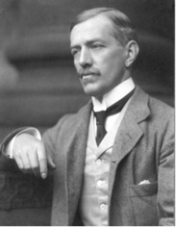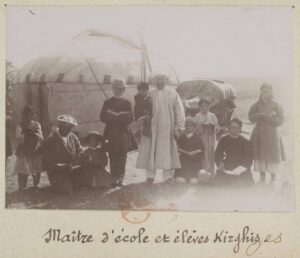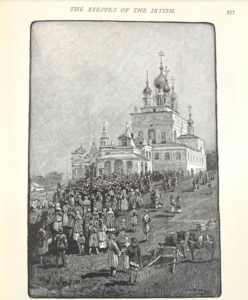Courtesy of Personal Library of Ambassador of Kazakhstan to the United States of America H.E. Erzhan Kazykhanov

Readers and followers of the Abai Center were genuinely impressed with the stories of English engineer J.W.Wardell who wrote about his experience at the Spassky mining field in 1914-1919.
Encouraged by such enthusiasm, we decided to share a beautifully written book by Edward Nelson Fell “Russian and Nomad: Tales of the Kirghiz Steppes”. The volume is full of remarkable and delightful narratives written during 11 years in charge of works of a large mining company. It was published by Duffield and Co. in New York in 1916.
To begin with, we would like to speak about Edward Nelson Fell’s life and share some interesting facts from his biography1 that connects generations of Kazakh, British and American people.
Nelson Fell, for whom Fell’s Point on East Lake Tohopekaliga and Fellsmere in Indian River County Florida take their names, had seen most of the world before arriving in Florida.
The youngest son in a British family of entrepreneurs, Fell already had an impressive worldwide resume before coming to Florida, where he founded two communities, the English colony of Narcoossee and the farming town of Fellsmere.
Fell’s father, Alfred, was an Englishman who in the mid-1800s took his wife and children to New Zealand, where he ran a successful wholesale business. Fell was born in Nelson, New Zealand, in 1857. The family, then including seven children, returned to England two years later.
One of the greatest English poets Alfred, Lord Tennyson, a neighbor when the family was living on the Isle of Wight, mentored Nelson Fell on the arts and literature, including his own poetry. Fell’s father later sent him to Heidelberg for a year to learn German engineering techniques.
After meeting with his brother in London in 1901, Nelson Fell’s destination was the great treeless plains of Central Asia. Arthur Fell had become a member of the British Parliament where he “had learned that there were tremendous investment opportunities in Central Asia”.
From 1902 to 1908 Edward Nelson Fell was directing the operations of a London mining company that purchased some copper mines, coal mines and smelting works in the center of the steppes, near the headwaters of the river Ishim, two hundred miles or more north of Lake Balkhash.
Edward Nelson Fell starts his book by saying, “the scenes of the tales which follow is laid in the Kazakh steppes, part of the Central Asiatic plateau, which is the ultimate birthplace of all our western modes of thought and culture and religion”2.
Like many western travelers, Nelson had very fond memories about the time he spent in the Kazakh steppe. Interestingly, the way he felt in the steppe and the way he portrayed it is very similar to what native Kazakhs would say:
The beauty of the Steppe is a beauty which fills the heart and masters the mind. The appeal is not made to the eye and the senses. It is true that there is a beauty of detail; acres of anemones which burst into blossom in the spring, wild roses which cover the hillsides a little later, and especially the wonderful colors in which the whole atmosphere seems bathed; but the real beauty is the limitless expanse which little by little feeds the mind with a sense of universal harmony.
Perhaps because of his childhood background when he was taught by one of the most prominent British poets, Edward Nelson’s depictions of Kazakh steppes were very poetic and tender. As the author puts in, there is no beauty in such country which can be described, but there is beauty which can be felt and he tried to show this through the stories in the book.
In his view, this is the oldest country in the world, the country which has been the longest settled by civilized man.3 For example, during his journey through Kazakh steppes he notices tombs and says that to an intelligent traveler, the really noteworthy feature of the work on tombs is that it is carried out in precisely the form and method of construction of two thousand years ago.
Nelson compares climate in Kazakhstan with that of North Americas. In his words, “the climate is severe; extremely hot and dry in the four months of summer, and extremely cold and stormy in the seven months of winter. The blizzards (bouran) compare favorably with the fancy variety which we have on the prairies of North American continent”4. At the same time, he notes that the one month of spring, is nearly sufficient in its delight to compensate for the severe extremes of the other eleven. The earth and sky reawake to such a glory of life and color that is unknown to the dweller in more temperature climes. The song of the thousand skylarks which rise before your carriage, as you drive along in the early morning, chases away temperature memories of the wintry chains which have bound the earth for so long.
According to Fell, copper deposits are found over a wide area. The number and extent of them is extraordinary. The ores are oxidized from the surface to a depth of about seventy feet, and a zone of secondary enrichment extends to three hundred feet. Some of these deposits, Fell notes, are of such size and richness that it is possible that this district may some day become a factor in the world’s copper production.
On the other hand, the author explains, there are coal deposits of vast extent and they are often found side by side with the copper mines.
An interesting botanical feature he observes in connection with the copper deposits. At a certain time of the year, according to Fell, a little pink flower appears in blossom, wherever there are signs of copper and nowhere else. Standing on the hill, these flowers could be observed in patches and wherever they were seen, copper signs were always found.
During the past few months, our readers had a chance to learn how western travelers described Lake Aral and Syr Darya as well as major Kazakh cities of that time such as Vierney, Aulie-Ata, Turkistan. Fell’s travelogues are unique in many ways including his depictions of Lake Balkhash. He calls it Turquoise Lake and says that tempting with rumors of its beauty and varied animal life, Balkhash, the second largest lake in Asia has been the goal of his winter dreams. In this book, Fell also shares “The Turquoise Lake” and also “The Eagle Song” which follows “A Hunt with Eagles” that were written by his daughter Marian, whom he calls “kizimka”.
Nelson was also very fond of Kazakh personality. In his words, Kazakhs are scrupulously clean about their persons and if you are with them at night, you will see them take off their sodden and worn outer coverings, and taking off layer after layer, they will gradually emerge in a spotless silk undergarment of a voluminous pyjama variety, and their skin is as fresh as the silk itself. At all times, he continues, their personal habits are delightful; they do not drink or smoke or chew or spit, they would rather starve than eat their food, filthy as it may be, without first washing their hands. It is impossible for them to enter a tent or a house without removing their outer boots, inside of which they wear another pair of boots to the knee, but made of their soft gaily colored and embroidered leather. He also continues saying that if the Kazakh has learned his delightful personal habits from the teachings of Mahommed, he can personally only regret that the western religions overlooked these details.
Fell’s book that we so highly recommend, contains many more enticing stories and observations as well as wonderful illustrations. From his travels to Akmolinsk (present day Nur-Sultan) to Pavlodar, fine dining and tasting of delicacies at the local clubs and restaurants to authentic experience of observing eagle hunting, women wrestling, assembling the yurt and etc. – this volume is an absolute must read for anyone interested in Kazakhstan and Central Asia of early 1900s.
- https://www.findagrave.com/memorial/24969762/edward-nelson-fell ↩
- p. 6 ↩
- p. 9 ↩
- p. 20 ↩






